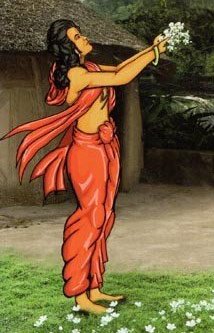Dhumasikha, Dhūmaśikha, Dhūmasikha, Dhumashikha, Dhūmasikhā, Dhuma-sikha: 10 definitions
Introduction:
Dhumasikha means something in Buddhism, Pali, Hinduism, Sanskrit. If you want to know the exact meaning, history, etymology or English translation of this term then check out the descriptions on this page. Add your comment or reference to a book if you want to contribute to this summary article.
The Sanskrit term Dhūmaśikha can be transliterated into English as Dhumasikha or Dhumashikha, using the IAST transliteration scheme (?).
In Hinduism
Kavya (poetry)
Source: Wisdom Library: Kathāsaritsāgara1) Dhūmaśikha (धूमशिख) is the brother of Agniśikha, a Rākṣasa from the city of Dhūmapura, according to the Kathāsaritsāgara, chapter 39. Accordingly, as Agniśikha said to Śṛṅgabhuja, “only two yojanas from this place, in a southerly direction, there is an empty temple of Śiva in a wood. In it lives my dear brother Dhūmaśikha. Go there at once, and say this in front of the temple”.
2) Dhūmaśikha (धूमशिख) is the name of a Vidyādhara champion allied to Mandaradeva who marched in war against Naravāhanadatta, as mentioned in the Kathāsaritsāgara, chapter 109. Accordingly, “... and the next morning he worshipped Kālarātri, and marched thence to engage Dhūmaśikha, who had barred his further advance with an army of Vidyādharas. Then the emperor had a fight with that king, who was the principal champion of Mandaradeva, of such a desperate character that the air was full of swords, the earth covered with the heads of warriors, and the only speech heard was the terrible cry of heroes shouting, ‘Slay! Slay!’”.
The Kathāsaritsāgara (‘ocean of streams of story’), mentioning Dhūmaśikha, is a famous Sanskrit epic story revolving around prince Naravāhanadatta and his quest to become the emperor of the vidyādharas (celestial beings). The work is said to have been an adaptation of Guṇāḍhya’s Bṛhatkathā consisting of 100,000 verses, which in turn is part of a larger work containing 700,000 verses.
Source: archive.org: The ocean of story. vol. 8Dhūmaśikha, literally “the smoke-crested,” means “fire.”

Kavya (काव्य, kavya) refers to Sanskrit poetry, a popular ancient Indian tradition of literature. There have been many Sanskrit poets over the ages, hailing from ancient India and beyond. This topic includes mahakavya, or ‘epic poetry’ and natya, or ‘dramatic poetry’.
Purana and Itihasa (epic history)
Source: Wisdom Library: The Matsya-purāṇaDhūmaśikhā (धूमशिखा) is the name of a mind-born ‘divine mother’ (mātṛ), created for the purpose of drinking the blood of the Andhaka demons, according to the Matsya-purāṇa 179.8. The Andhaka demons spawned out of every drop of blood spilled from the original Andhakāsura (Andhaka-demon). According to the Matsya-purāṇa 179.35, “Most terrible they (e.g., Dhūmaśikhā) all drank the blood of those Andhakas and become exceedingly satiated.”
The Matsyapurāṇa is categorised as a Mahāpurāṇa, and was originally composed of 20,000 metrical verses, dating from the 1st-millennium BCE. The narrator is Matsya, one of the ten major avatars of Viṣṇu.

The Purana (पुराण, purāṇas) refers to Sanskrit literature preserving ancient India’s vast cultural history, including historical legends, religious ceremonies, various arts and sciences. The eighteen mahapuranas total over 400,000 shlokas (metrical couplets) and date to at least several centuries BCE.
In Buddhism
Theravada (major branch of Buddhism)
Source: Pali Kanon: Pali Proper NamesMentioned with Apalala, Culodara, Mahodara, Aggisikha and Dhanapala, as a beast tamed by the Buddha and converted to the faith. Sp.i.120.
Theravāda is a major branch of Buddhism having the the Pali canon (tipitaka) as their canonical literature, which includes the vinaya-pitaka (monastic rules), the sutta-pitaka (Buddhist sermons) and the abhidhamma-pitaka (philosophy and psychology).
Languages of India and abroad
Pali-English dictionary
Source: BuddhaSasana: Concise Pali-English Dictionarydhūmasikha : (m.) fire.
Source: Sutta: The Pali Text Society's Pali-English DictionaryDhūmasikhā refers to: fire (Ep. of Agni; lit. smoke-crested) Vv 352 (sikha)=VvA.161; Vism.416; also as sikhin J.VI, 206. (Page 343)
Note: dhūmasikhā is a Pali compound consisting of the words dhūma and sikhā.

Pali is the language of the Tipiṭaka, which is the sacred canon of Theravāda Buddhism and contains much of the Buddha’s speech. Closeley related to Sanskrit, both languages are used interchangeably between religions.
Sanskrit dictionary
Source: Cologne Digital Sanskrit Dictionaries: Cappeller Sanskrit-English DictionaryDhūmaśikhā (धूमशिखा).—[feminine] a column of smoke.
Source: Cologne Digital Sanskrit Dictionaries: Monier-Williams Sanskrit-English Dictionary1) Dhūmaśikhā (धूमशिखा):—[=dhūma-śikhā] [from dhūma > dhū] f. = -rāji, [Atharva-veda; Veṇīs.]
2) [v.s. ...] fee, salary, reward, [Vasiṣṭha]
[Sanskrit to German]
Sanskrit, also spelled संस्कृतम् (saṃskṛtam), is an ancient language of India commonly seen as the grandmother of the Indo-European language family (even English!). Closely allied with Prakrit and Pali, Sanskrit is more exhaustive in both grammar and terms and has the most extensive collection of literature in the world, greatly surpassing its sister-languages Greek and Latin.
See also (Relevant definitions)
Relevant text
Search found 6 books and stories containing Dhumasikha, Dhūmaśikha, Dhūmasikha, Dhumashikha, Dhūmasikhā, Dhuma-sikha, Dhūmaśikhā, Dhūma-sikhā, Dhuma-shikha, Dhūma-śikhā; (plurals include: Dhumasikhas, Dhūmaśikhas, Dhūmasikhas, Dhumashikhas, Dhūmasikhās, sikhas, Dhūmaśikhās, sikhās, shikhas, śikhās). You can also click to the full overview containing English textual excerpts. Below are direct links for the most relevant articles:
Sahitya-kaumudi by Baladeva Vidyabhushana (by Gaurapada Dāsa)
Text 10.61 < [Chapter 10 - Ornaments of Meaning]
Trishashti Shalaka Purusha Caritra (by Helen M. Johnson)
Part 11: Story of Amitagati < [Chapter II - Marriages of Vasudeva with maidens]
Kathasaritsagara (the Ocean of Story) (by Somadeva)
Chapter XXXIX < [Book VII - Ratnaprabhā]
Chapter CIX < [Book XV - Mahābhiṣeka]
Note on the “magic obstacles” motif < [Notes]
The Great Chronicle of Buddhas (by Ven. Mingun Sayadaw)
Buddha attributes (6): Anuttaropurisa damma sārathi < [Chapter 42 - The Dhamma Ratanā]
Maha Prajnaparamita Sastra (by Gelongma Karma Migme Chödrön)
Part 9 - Why is the Buddha called Puruṣadamyasārathi (puruṣa-damya-sārathi) < [Chapter IV - Explanation of the Word Bhagavat]
Visuddhimagga (the pah of purification) (by Ñāṇamoli Bhikkhu)
(1) Recollection of the Enlightened One < [Chapter VII - Six Recollections (Cha-anussati-niddesa)]